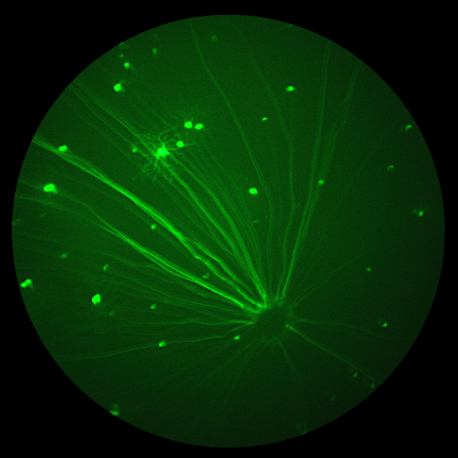Glaucoma, a leading cause of irreversible vision loss, is characterized by progressive damage to retinal ganglion cells (RGCs) and the optic nerve, often associated with increased intraocular pressure (IOP). While previous studies have implicated Tau protein expression and phosphorylation changes in other neurodegenerative diseases such as Alzheimer’s disease, Parkinson’s disease and glaucoma, the causative role of Tau in glaucoma pathology remains unclear.
In the recent paper “Tau Modulation Through AAV9 Therapy Augments Akt/Erk Survival Signaling in Glaucoma Mitigating the Retinal Degenerative Phenotype”, researchers from Macquarie University, Sydney, Australia utilized MICRON ocular imaging technology to investigate the impact of Tau protein modulation on retinal neurons under normal and experimental glaucoma conditions. Using AAV9-mediated gene therapy, the team of Kanishka Pushpitha Maha Thananthirige et al, led by Vivek Gupta manipulated Tau expression levels through overexpression and knockdown approaches in mouse models.
The MICRON Ganzfeld ERG enabled the researchers to comprehensively evaluate functional retinal changes. The positive scotopic threshold response (pSTR) and whole eye ERG amplitudes were measured to determine the effects of Tau overexpression and knockdown on retinal function. Under healthy conditions, both Tau overexpression and knockdown adversely affected retinal structure and function, as well as neuroprotective Akt/Erk survival signaling, highlighting the importance of optimal Tau levels for retinal integrity.
In the experimental glaucoma model, Tau overexpression exacerbated inner retinal degeneration, while Tau silencing provided significant protection against these degenerative changes. The MICRON Ganzfeld ERG allowed for detailed assessment and validation of structural and functional alterations observed in the ganglion cell layer (GCL). It revealed significant declines in pSTR amplitudes which correlated with GCL density loss, providing valuable insights into the role of Tau in glaucoma pathology.
The findings from this study underscore the critical role of endogenous Tau protein levels in preserving retinal health and suggest the potential therapeutic benefits of targeting Tau in glaucoma. By employing MICRON ocular imaging technology, the researchers were able to uncover the intricate relationship between Tau and retinal neuron survival, paving the way for future investigations and treatment strategies.
As glaucoma remains a leading cause of blindness worldwide, understanding the underlying molecular mechanisms is crucial for developing targeted therapies. The work of KPM Thananthirige and team, supported by MICRON technology, represents a significant step forward in elucidating the role of Tau in glaucoma pathology and highlighting the potential of Tau-targeted gene therapy approaches.
Reference:
Thananthirige, K. P. M., Chitranshi, N., Basavarajappa, D., Rajput, R., Abbasi, M., Palanivel, V., Gupta, V. B., Paulo, J. A., Koronyo-Hamaoui, M., Mirzaei, M., Graham, S. L., & Gupta, V. (2024). Tau modulation through AAV9 therapy augments Akt/Erk survival signalling in glaucoma mitigating the retinal degenerative phenotype. Acta Neuropathologica Communications, 12(1), 89. https://doi.org/10.1186/s40478-024-01804-0




